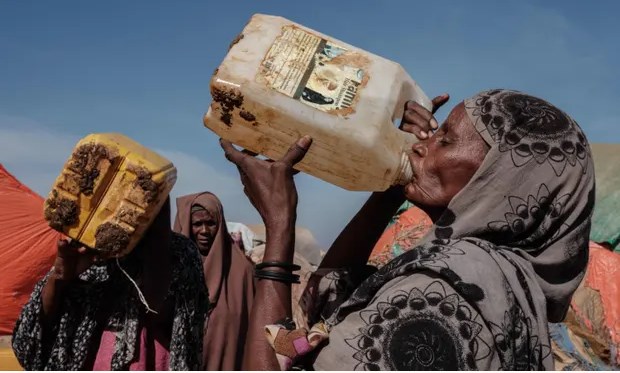The perilous trek to Europe is known among Somalis as “going on tahriib,” a term usually connected with illegal operations like as trafficking or smuggling. Those who attempt it travel by vehicle via Ethiopia, Sudan, and Libya, then on boat over the Mediterranean to Europe — assuming they make it that far.
Their families frequently pay tens of thousands of pounds to smugglers who may not keep their promises, raising fees or abandoning victims too soon. Nonetheless, individuals continue to attempt. Climate change is increasingly being cited as one of the causes.
Abdirahman Nur Hassan, a local elder and member of the drought committee in the town of Dollow in south-west Somalia, told me that illegal voyages to Europe used to be rare in this region and were related to youth unemployment, “but now it is becoming common”. Drought is destroying people’s livelihoods and causing them to look for other options, he said. “If this drought continues, things will get worse, the remaining animals will die, and the majority of people living in this area will end up displaced.”
Somalia is in a terrible state. Following three unsuccessful rainy seasons, six million people are experiencing crisis levels of food insecurity, with 81,000 people considered to be in famine. Hundreds of thousands of children could perish if proper assistance is not provided, according to the United Nations. This year, 1.4 million youngsters are likely to suffer from acute malnutrition.
According to the Norwegian Refugee Council, the recent drought has affected 745,000 individuals, the bulk of them have been moved since January. Given that the Islamic militant group al-Shabaab controls significant areas of territory, making it risky for government officials or relief agencies to enter, accurate numbers on deaths are difficult to come by.
Droughts have become more intense and severe as a result of the climate issue and rain less predictable. The Earth’s temperature has already risen by 1.1C, and Somalia – listed as one of the most vulnerable countries in the world to climate change – is a place where you can see the immediate impacts.
A famine there killed 250,000 people in 2011. Droughts are cyclical, so sufferers don’t have time to recuperate before the next one hits. The temperature in Somalia is anticipated to rise by 3 degrees Celsius by the end of the century.
Although western emissions are mostly to blame for the climate problem, this has rarely translated into more assistance for developing countries struggling with its consequences. Despite having a population just over four times that of Somalia, the UK produced 520 times its emissions in 2018 (the most recent year for which World Bank data is available), down from 933 times in 2006.
According to the Intergovernmental Panel on Climate Change, more than 20 million people perish each year as a result of climate change. displaced by extreme weather events since 2008. Most stay within their own countries, and in Somalia I’ve seen them: tens of thousands of people in a makeshift camp, with no toilets, no water, children crying from hunger, now fearful of the rain, which will turn the area into an open sewer that spreads disease.
Speaking to me on the phone this week, Dr Sukri Hussein Abdi, who works in a Somali stabilisation ward for malnourished children, where they have treated more than 400 children over the past few months, said the effects of the drought are “indescribable”. “People are dying from starvation, we need humanitarian assistance, food, shelter, water to help these people, to save lives, especially.”
Last year, the UK cut its foreign aid budget by billions of pounds. In Somalia, a humanitarian response plan put together by the UN has been drastically underfunded.
But allowing migration can be a more efficient form of foreign aid. Allowing people in developing countries to more easily travel by safe and legal routes to richer countries gives them a stable place to go, and means they can also get a job and send money back home. In 2020, the World Bank said Somalia received more than $1.7bn in remittances, equating to nearly 25% of its GDP.
In a shop in Dollow, I met businessman Abdiweli Dirie Osman. Every five days he collects up to $300 from Somalis who have made it abroad, and uses it to buy bags of rice, sorghum, cooking oil and other essentials, which he distributes to families in need. “The diaspora collect what they can,” he said. This kind of charity is being repeated across the country.
Osman’s sister has been in Germany for the past 10 years. “Every family has someone [in Europe],” he said. “Life is very difficult here, there are the cycles of drought. They want a change from the standard of living.”
Osman had no idea how many people from this region have left for Europe. “They’ve been going for so long, it’s impossible to count them. It happens all the time,” he said. During the drought, he too hears that the numbers are increasing.
When I asked him if he knew about the dangers involved, he laughed. “People are good at taking risks. That is the route. We’re hoping one day that there will be safer routes they can take. It helps society; in times of drought they can help the society.”
With every degree that the temperature across Earth rises, experts say, roughly one billion people will either be displaced or forced to live in insufferable heat. We urgently need to ask how to improve the situation, for both those who leave and those who stay.
Sally Hayden is a journalist and the author of My Fourth Time, We Drowned: Seeking Refuge on the World’s Deadliest Migration Route

